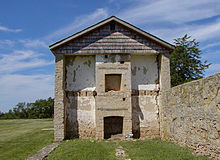
The Black Hawk War was a conflict between the United States and Native Americans led by Black Hawk, a Sauk leader. The war erupted after Black Hawk and a group of Sauks, Meskwakis (Fox), and Kickapoos, known as the "British Band", crossed the Mississippi River, to the U.S. state of Illinois, from Iowa Indian Territory in April 1832. Black Hawk's motives were ambiguous, but he was apparently hoping to reclaim land that was taken over by the United States in the disputed 1804 Treaty of St. Louis.

Fort Atkinson is a city in Winneshiek County, Iowa, United States. The population was 312 at the time of the 2020 census. It is home to the historic Fort Atkinson State Preserve and hosts a large annual fur-trapper rendezvous each September. Fort Atkinson holds the largest regional hay auction every Wednesday.

Fort Snelling is a former military fortification and National Historic Landmark in the U.S. state of Minnesota on the bluffs overlooking the confluence of the Minnesota and Mississippi Rivers. The military site was initially named Fort Saint Anthony, but it was renamed Fort Snelling once its construction was completed in 1825.
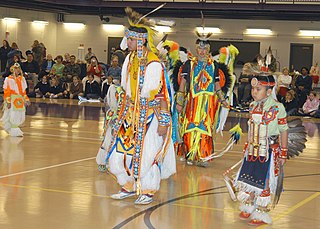
The Ho-Chunk, also known as Hocąk, Hoocągra, or Winnebago, are a Siouan-speaking Native American people whose historic territory includes parts of Wisconsin, Minnesota, Iowa, and Illinois. Today, Ho-Chunk people are enrolled in two federally recognized tribes, the Ho-Chunk Nation of Wisconsin and the Winnebago Tribe of Nebraska.

Henry Atkinson was a United States army officer serving on the western frontier during the War of 1812 and the Yellowstone expedition. With Benjamin O'Fallon, he negotiated treaties with Indigenous nations of the upper Missouri River in 1825. Over his career in the army, he served in the West, the Gulf Coast, and in New York at the border with The Canadas.

The Winnebago War, also known as the Winnebago Uprising, was a brief conflict that took place in 1827 in the Upper Mississippi River region of the United States, primarily in what is now the state of Wisconsin. Not quite a war, the hostilities were limited to a few attacks on American civilians by a portion of the Winnebago Native American tribe. The Ho-Chunks were reacting to a wave of lead miners trespassing on their lands, and to false rumors that the United States had sent two Ho-Chunk prisoners to a rival tribe for execution.
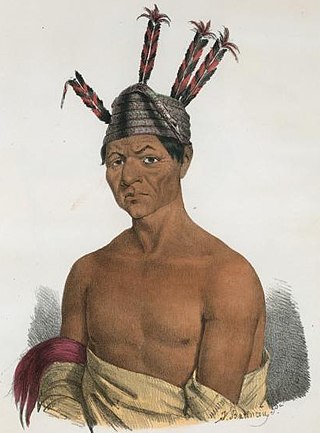
Waukon Decorah, also known as Wakąhaga (Wau-kon-haw-kaw) or "Snake-Skin", was a prominent Ho-Chunk (Winnebago) warrior and orator during the Winnebago War of 1827 and the Black Hawk War of 1832. Although not a hereditary chief, he emerged as a diplomatic leader in Ho-Chunk relations with the United States.
Thomas W. Sutherland was an American lawyer and pioneer settler of Wisconsin and California. He was the first Village President of Madison, Wisconsin, was United States Attorney for Wisconsin for several years in the 1840s, was a member of the first Board of Regents of the University of Wisconsin, and was the last Alcalde (Mayor) of San Diego, California, prior to statehood.

Fort Winnebago was a 19th-century fortification of the United States Army located on a hill overlooking the eastern end of the portage between the Fox and Wisconsin Rivers east of present-day Portage, Wisconsin. It was the middle one of three fortifications along the Fox-Wisconsin Waterway that also included Fort Howard in Green Bay, Wisconsin and Fort Crawford in Prairie du Chien, Wisconsin. Fort Winnebago was constructed in 1828 as part of an effort to maintain peace between white settlers and the region's Native American tribes following the Winnebago War of 1827. The fort's location was chosen not only because of its proximity to the site of Red Bird's surrender in the Winnebago War, but also because of the strategic importance of the portage on the Fox-Wisconsin Waterway, a heavily traveled connection between the Great Lakes and the Mississippi River. Fort Winnebago's location near the portage allowed it to regulate transportation between the lakes and the Mississippi.
Yellow Thunder, was a chief of the Ho-Chunk tribe. He signed two treaties with the United States in which his Ho-Chunk name was given as Wa-kun-cha-koo-kah and Waun-kaun-tshaw-zee-kau.

Lloyd James Beall was a senior officer of the Confederate States Marine Corps who attained the rank of colonel and served as the Commandant of the Confederate States Marine Corps from May 23, 1861, to April 9, 1865.

The Winnebago Tribe of Nebraska is one of two federally recognized tribes of Ho-Chunk Native Americans. The other is the Ho-Chunk Nation of Wisconsin. Tribe members often refer to themselves as Hochungra – "People of the Parent Speech". Their language is part of the Siouan family.

James McGowan Strode (1804–1857/1860) was a militia officer and politician from the U.S. state of Illinois. He served in the Illinois militia during the Winnebago War and the Black Hawk War. Strode, originally from Tennessee, lived much of his life in Galena, Illinois. In Galena, during the Black Hawk War he was given command of the 27th Regiment of the Illinois militia and oversaw the construction of a fort in that city. Strode was involved in combat during the war at the infamous Battle of Stillman's Run. In 1835 Strode was elected to represent much of the region of Illinois north of Peoria in the Illinois State Senate.
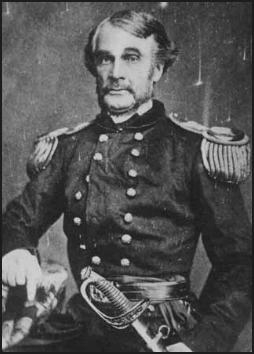
Edmund Brooke Alexander was an officer in the United States Army in the Mexican-American War through the American Civil War who rose to the rank of brevet Brigadier General in 1865.
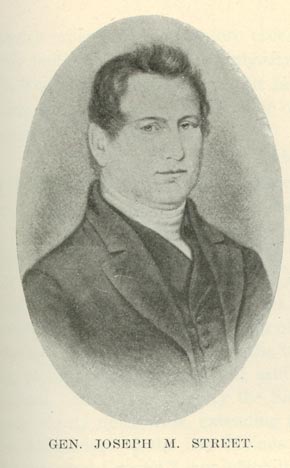
General Joseph Montfort Street was a 19th-century American pioneer, trader and US Army officer. During the 1820s and 1830s, he was also a U.S. Indian Agent to the Winnebago and later to the Sauk and Fox tribes after the Black Hawk War. His eldest son was Joseph H. D. Street, the first appointed registrar of the Council Bluffs Land Office in western Iowa.

The Winnebago Reservation of the Winnebago Tribe of Nebraska is located in the U.S. in Thurston County, Nebraska, United States. The tribal council offices are located in the town of Winnebago. The villages of Emerson, south of First Street, as well as Thurston, are also located on the reservation. The reservation occupies northern Thurston County, Nebraska, as well as southeastern Dixon County and Woodbury County, Iowa, and a small plot of off-reservation land of southern Craig Township in Burt County, Nebraska. The other federally recognized Winnebago tribe is the Ho-Chunk Nation of Wisconsin.
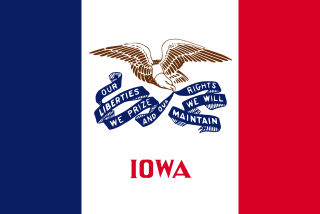
The following outline is provided as an overview of and topical guide to the U.S. state of Iowa.

Several Native American tribes hold or have held territory within the lands that are now the state of Iowa.
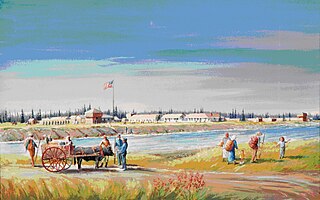
Fort Ripley was a United States Army outpost on the upper Mississippi River, in mid-central Minnesota from 1848 to 1877. It was situated a few miles from the Indian agencies for the Ho-Chunk and Ojibwe in Iowa Territory and then the Minnesota Territory. Its presence spurred immigration into the area and the pioneer settlement of Crow Wing developed approximately 6.75 miles (10.86 km) north of the fort. The post was initially named Fort Marcy. It then was renamed Fort Gaines and in 1850 was renamed again for distinguished Brigadier General Eleazer Wheelock Ripley of the War of 1812. It was the second major military reservation established in what would become Minnesota.


